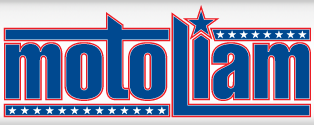November, 2006
November 28, 2006
Time for a MASSIVE UPGRADE, oh, and Happy Birthday, to me!
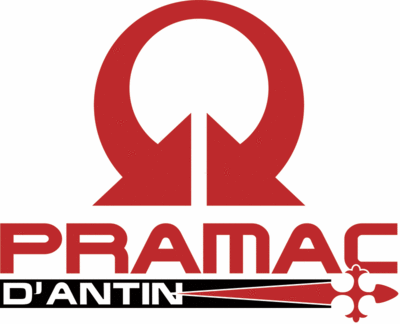
2006 is over. The World Championship has come and gone. Now it's time to prepare for 2007.
Now it's time to ROCK-N-ROLL, baby!
Next season promises new 800cc racebikes, new challenges, a new campaign, and I am extremely proud to announce that I will continue my assault on the MotoGP World Tour in 2007 as an integral part of Pramac D'antin Ducati!
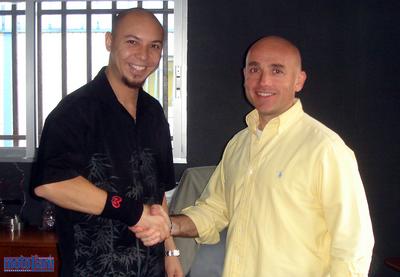
I travelled to Madrid on Monday to meet with Luis D'antin and confirm my position for next year, which will see me taking a massive step forward and furthering my knowledge of the international racing business, and in particular, all the details about the new Ducati GP7!
I always want to do my best and help my team to the fullest of my abilities. Last season I worked on
Alex Hofmann's crew, but next year I will be placed where I can help my team and work for both riders. If you think that doing your all for one rider is cool, just imagine being able to help two riders! In view of wanting to do as much as possible for the team, I will now be taking over the Parts and Logistics Coordinator position, facilitating all our spare parts needs directly through Ducati Corse, and managing them throughout the season at racetracks around the world. It is an awesome responsibility, but I am sooo hungry - and I'm ready for the challenge! I truly believe 2007 is going to be a break-out year for the Pramac D'antin team, and this is why I have chosen to stay with them and once again do my best so that everyone around me can do their best. I had some other options for the '07 season, but honestly, I love working with my teammates and I can't think of anything more rewarding than being a critical element in my team's structure and helping to build a solid foundation for the coming championship series. The job has now blossomed from High Pressure, to Hyper Pressure, because one oversight or mistake could cost us valuable time, money, or worse - a race! I'll need to be on my game to ensure that my team has Everything they need to get the job done, no matter what. On the lighter side, I will get to know every single piece of the GP7 intimately, and for a "lego-fiend" like me, I think that's going to be really fun. I'm sure that it won't be long before I'm able to visualize the complete bike in my head and rattle off part numbers, codes, and installation/replacement procedures. At least I hope so!
As I learn more about the current systems, and we develop new computer programs for doing things, I hope to be able to place my team on a higher level of competitiveness than we managed in 2006. It is my goal this season to do my best to raise the level - because I want to win races. Sure, I had a strong option to move to a squad that has won races, and I'm sure they will win races again, but I wouldn't have helped build that team. I'm helping to build this team, this family. It's my family. In my heart, I'm still a mechanic, though, and I still look at life as a series of problems that I try to fix. I just make sure that I put my all into living at the maximum, because you never know when the wheel will stop turning. My duties and responsibilities have increased exponentially now, so I'm unsure of what I'll be able to write about. Moreso, I am not sure I'll have the time to really do it up like I did last year! What a complete turnaround from my 30th Birthday in 2005.
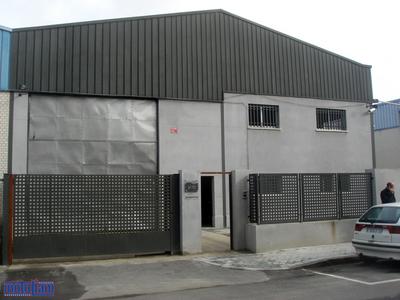
I expect to spend some more time in Madrid, 30 minutes outside of the Barajas airport at the Pramac D'antin raceshop! Highly fortified, discrete, and massive.
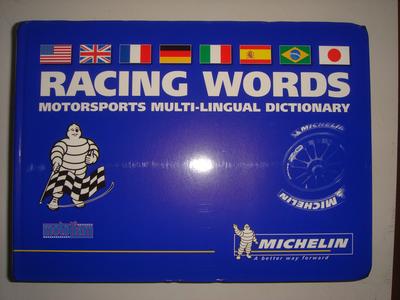
My birthday present? Talk about practical! An eight language racing dictionary that I will use to help me translate some of the more technical information that comes my way. Working in the box with the other mechanics last year, I was amazed at how much you can communicate with hand gestures (and finger gesticulations, haha), and some choice words. To be honest, I never felt 100% comfortable because sometimes things got pretty complex, and my lack of perfect language comprehension could have been a problem because time is always of the essence at the track. Now, I've got a new book to help me improve that much more. Right On!
I'd like to take a moment to thank everyone who has been behind me this year, supporting me with time, encouragement, and supplies throughout my first season in MotoGP. Thank you MotoLola, Evan and Joanne, Brad, Ian, Bob, the members of Barf, all the guys at MotoStrano, and of course, all my teammates from D'antin MotoGP. They say the first year is the hardest, but with everything I've got on my plate for 2007, I think it's only going to get more difficult - and that much more rewarding! I've never believed in taking the easy route, and feel that learning from the bottom up is the only way to go to truly understand and master something. Tonight, I'm raising a glass to celebrate my 31st, and also to kick off my new job in the 2007 MotoGP World Championship.
It's time to get to work. Let's rock!
MotoStrano, my personal sponsor and supplier of killer clothing, apparel, and luggage. I couldn't have made it as far as I did without you guys. What can I say? MotoStrano, with me all the way in MotoGP!
Axio Hardpacks, the best bag I've come across! I them use to protect the computers I travel around the world with. Worth it's weight in gold. Thanks Bob!
The Pramac D'antin Ducati website will be undergoing some significant changes during the off-season, and I'm hoping to change a couple things up on my own website, as well. Stay tuned.
We're putting the band back together, so expect to hear all about it when www.MotoGPod.com starts up again this off-season.
November 25, 2006
Happy Thanksgiving - Sazzerack Style, 2006!
Thanksgiving in Spain - just another Thursday in Barcelona! I actually didn't realize Thanksgiving was upon us, until someone mentioned it to me on Wednesday. One problem living outside of the U.S. is missing all of the typical holidays, though Spain more than makes up for it by having more holidays than any other country I've ever seen. Come to think of it, August seems like a month long holiday, too. I woke up on Thursday, determined to have myself a nice little dinner celebration, and boy, I didn't disappoint! With a little help from Sazzerack, that is. If you're looking for a good meal in Barcelona that won't break the bank, head on over to the corner of Cansell de Cent and Carrer de Villarroel.
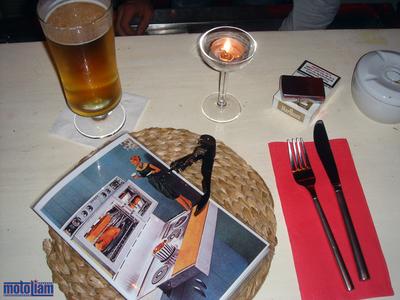
Much like last year, when I spent almost all of my important dates at Sazzerack, I returned once again for my second Thanksgiving in Barcelona. Sazzerack is one of my favorite restaurants, offering a beautiful mix of well prepared meals in various styles. Eastern? Western? They have you covered, and the decor is wonderful as well. I ordered my meal and while I was waiting for it to be prepared by "Mom", one of the waiters screwed up on a drink order, and voila, it became my treat. Desert first? Sure!
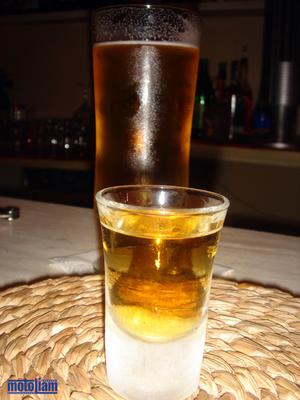
Waitaminnit - Who's Mom? The staff of Saz' is quite small, and it's run by a German mother and son duo. He takes care of the front of the house, while Mom oversee's the kitchen staff and monitors all the food that is served. She's also the one responsible for this fantastic French Salad, which had roasted bacon chunks and spiced mushrooms (and they were still hot from the saute pan when I got my salad - YUM!).
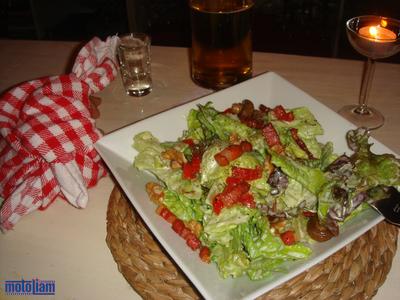
If you're going to have a Thanksgiving abroad, do it right and make it something to remember! I looked over the meat dishes, but decided that fish was the way to go. It was a good decision, and the noodles, slightly al dente, complimented the ginger cream sauce on the fish perfectly.
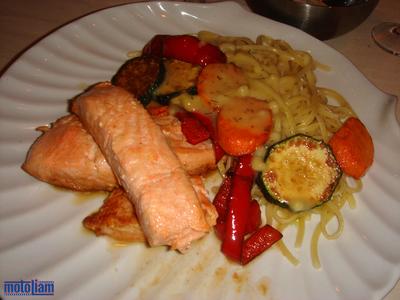
And what better way to wrap up a nice, quiet Thanksgiving? Apple pie ala mode! How awesome is that?!?! It's the little things that keep me rolling!
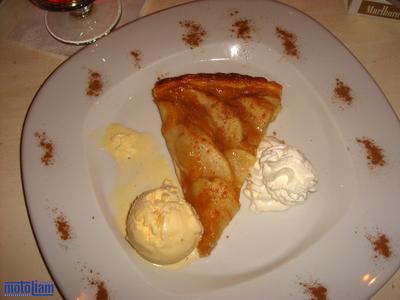
Extra special notes this week - Marlboro Ducati's Mark Elder celebrated the birth of his first child earlier in the week, and his daughter is a joy to behold. Right on, Mark!
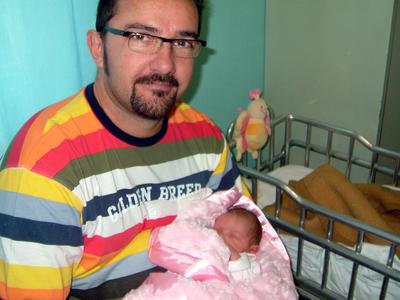
And also, Happy Thanksgiving, Spike! Hope your days in Hawaii are funfilled and stress free.
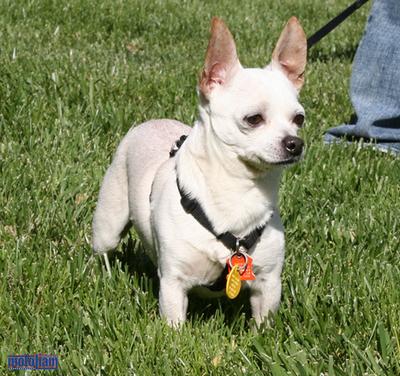
I hope everyone was able to spend this day with their friends and loved ones, and my best wishes go out to all of you.
November 22, 2006
Things that go Brraaaapp in the night, on Montjuic
Sunday is a beautiful day to go for a walk. In Spain, most of the shops and commercial centres are closed for business, so there really isn't anything to do but
A) Sit at the beach and drink CAVA
or
B) Take a hike.
Me? I like taking hikes. I like flying Kites, too. And jumping in a lake? You bet! Ok, just kidding on that last one. I have a particular aversion to stagnant bodies of water, like landbound lakes, and this comes from growing up in the middle of the biggest body of water in the world, the mighty Pacific Ocean. Part of me will always think that lakes are dirty, and you won't find me fishing in one. Still, I haven't spent time in any of the Great Lakes in North America, and I know you can surf there (saw it in
Step Into Liquid.) Regardless, I'm a long way from my own beloved waves, so on Sunday I went walking. It wasn't really my idea, but my old friend, Nacho (henceforth known as Big Nach) called me up and told me to meet him in Plaza Espanya, which is at the base of Montjuic and fairly close to my new apartment.
Montjuic is a beautiful hill which is now home to the Palau Nacional, the National Art Museum of Catalunya , and also some of the Olympic Stadiums. It's a beautiful area, a nice place to ramble through, and once I met the world's ugliest dog out here. Montjuic also hosted four Spanish Grand Prix races in the early seventies, and there was a famous 24 hour endurance race that used to take place on the very streets going up and around the hill, sort of like a mini Isle of Man TT. I strolled on down around 5PM, just in time to catch one of the more spectacular sunsets in my life. Nacho told me to make my way to Palau St. Jordi, which was near the top, so I had some more walking ahead of me - just what my swollen knee wanted, haha.
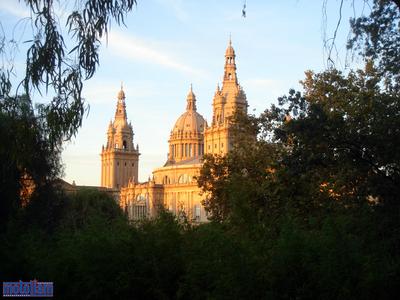
The plus side was that I had something to get to. . . .
From Plaza Espanya, which is really just a big roundabout with a tall monument in its center, head South West towards the National Museum.
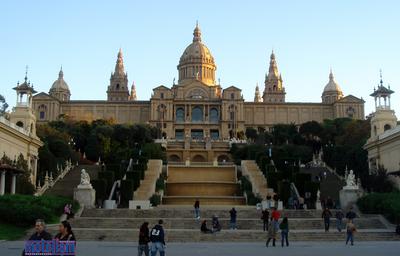
When you get to the Museum, turn around and look back at the sleepy city below you. I was lucky. The sun was still shining and a golden brown light poured over the city's buildings.
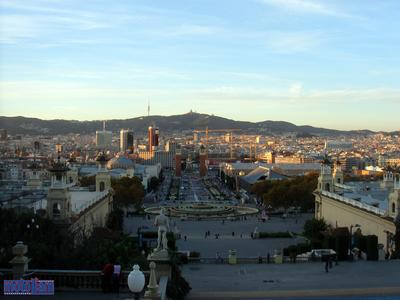
I was getting close, just as the daylight was saying goodnight. This is one of my favorite structures in Barcelona, Santiago Calatrava's giant radio tower.
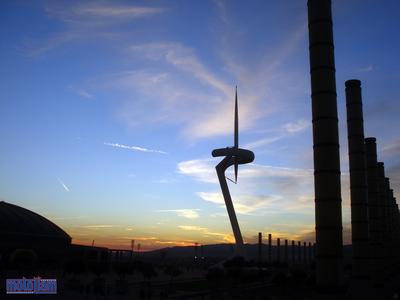
Just in time for one of the alltime great Sunsets I've experienced. All the small lights in the city were sparkling in the haze of dusk. Twinkling, like stars. This picture doesn't do it justice, but I was struck thinking about how much has happened in the last year, and here I stood, watching over my new city. It was a special moment.
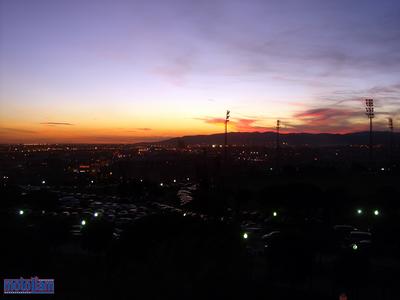
THe night wore on, and I fiddled with my camera, playing with the night mode settings.
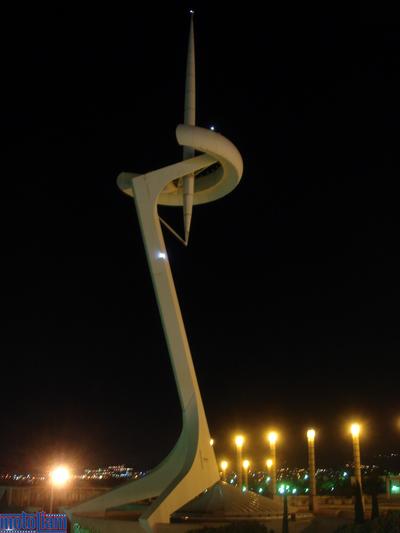
The "artsy" shot.
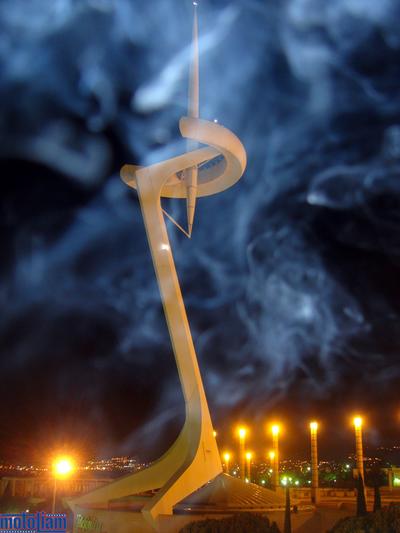
And the reason I was here - the Barcelona Supercross! Nacho had invited me out to be a part of the night, and we had fantastic passes to make the night quite memorable. I've raced Arenacrosses before (similar to Supercross, but in smaller venues), and there is nothing quite like lining up with a bunch of loud dirtbikes and flying off once the gate drops. It's a sound that's burnt into my head, and I absolutely love it. The racing throughout the night was fantastic, and all of us were treated to a show as David Vuillemin ran away from Nick Wey. There were a few Americans competing that night, including Mike Brown on a Kawasaki, and during the intermission there was a fun FreeStyle jump contest. Americans Wiley Fulmer and Beau Bamburg really impressed me, but ultimately the night belonged to a Spaniard.
It doesn't matter to me much - if it has two wheels, a motor, and some guys competing - I want to be there!
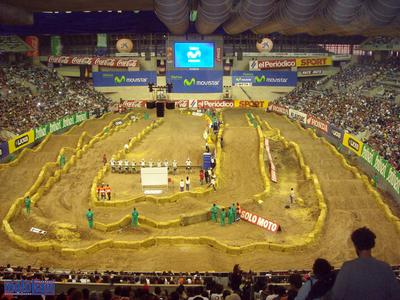
Big ups to Nacho, and Movistar, for the hospitality and the chance to check out something fun.
November 18, 2006
Splat! MotoLiam takes a tumble, and learns something!
Minutes after posting the Ducati Museum photos, I was headed home from Planet Cafe, the internet haven I usually hang out at here in Barcelona. Normally, this would have been like any other bicycle ride back to my apartment, but this time I made a mistake.
It had been raining off and on that day, and it was something I noted as I put the power to the pedals of my trusty black Haro BMX. My rear tire spun up a couple times from the incredible torque I make when I'm really hustling (haha), but I didn't mind one bit - because I like breaking traction! The night air was clean, and the streets were relatively empty, so I was making good time headed down towards the water, via the sidewalks. I saw the roads were dry, and I was doing my usual "sprint, coast, sprint, coast" on the bike, making time and hopping off of curbs when I could. Eventually, I had to turn right, and I sure chose the wrong place! I ducked under a tree and initiated a fast right sweeper while on the downstroke, or "powerstroke" of the right pedal, and almost before I could react, I was headed straight for the concrete. It felt like both wheels lost traction, though the rear broke loose first. I remember holding the bars and twisting my body to try and bring the back end around and back in line, but it was hopeless. I only managed to line myself up more for one of the roughest Belly-flops I've ever experienced, arms outspread, legs straight back behind me, and right torso parallel with the ground. . . . . . .
BLAMM-O! Superman I was not!
I hit my ribs and stomach so hard I knocked the wind out of myself something fierce, and it was a few moments before I could pull my arms and legs in to see if they were still attached. I curled up and managed to pick myself up, propping my hands on my knees while bent over, breathing heavily. "Wow! That was really something!", I thought, and for the first time I can remember, I didn't immediately rush over and see how the bike was doing. Maybe because this one didn't have a motor I needed to keep running, or maybe because I don't normally eat it so hard on the concrete without any gear.
Yeah, I said it. No Gear. Rolling around on the street (sidewalks almost always), I don't normally put the pads on, because I'm only commuting and not stunnin'. I don't wear a helmet either, because I haven't found one that does the trick (but probably because I couldn't justify the expense, and I don't have money to spare). Suffice it to say, I don't actually own any safety gear anymore, having given it all away when I moved to Europe last year. My fantastic Fox elbow/forearm pads (went through three or four different pairs before I found the ones that worked best with me), my old Bell full face BMX helmet (also great for XR50 racing), and the generic knee-braces I used - all gone now. Which brings me to my next subject.
Yesterday it was revealed that Nicky Hayden rode with a broken/cracked bone in his shoulder during the Valencia GP. He damaged it in his pile-up with Dani Pedrosa in the previous race at Estoril, but kept the injury under wraps so he wouldn't give title rival, Valentino Rossi, any more ammunition in the mental battle that was to ensue on the track at the final race. Nicky will miss the final winter pre-season test in Jerez in two weeks because he's having surgery to fix it, and also correct a collarbone issue (just another plate removal, nothing serious, haha). It's not really publicized too much when a rider does go down, other than the occasional short blurb about so-and-so falling in practice, or qualifying. After my most recent wreck, it's come back into the forefront of my mind that these guys are in great shape, and they take some hard hits without complaint. Sure, sometimes they're forced to sit out, or get surgery, but for the most part, if they're able to, they're back out riding as soon as possible. While I'm not comparing myself to a MotoGP athelete, anyone who hits the ground has to make a choice to come back and get on the horse again. I've managed to hit the ground quite a bit, but I always come back, and I went for a long ride earlier this afternoon to shake it off and get the juices flowing in my body again. Torso feels twisted, and I'm definitely having trouble breathing, but you know what? It was great! I know that my body will be back to normal in a couple weeks, and hopefully the swelling in my left thumb does down so I can type normally again. Nearest I can tell, I was still hanging on to the bars with my left arm when I went boom, and the resulting wrench of the bars out of my hand twisted it. At least my collarbones are fine (for the moment),haha, because I've broken both of my clavicles in various activities, the first time before I was even a year old! In honor of that, and also Nicky's impending Collarbone surgery, here's a great song called Collarbone!
Recuperative medicine also includes more moto-based fuel, this time in the form of Smacks! Where else but Spain can you find Superbikes on a cereal box for kids, and the back shows a couple of MV Augusta F4's. Sweet!
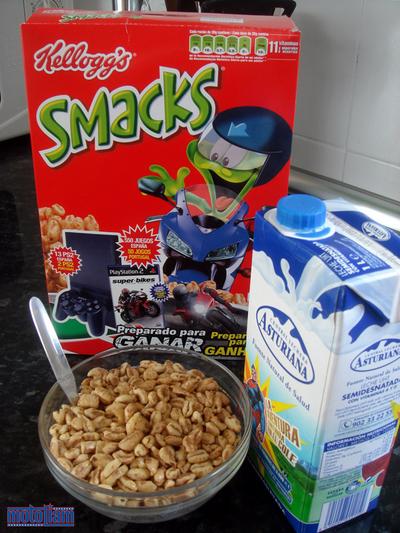
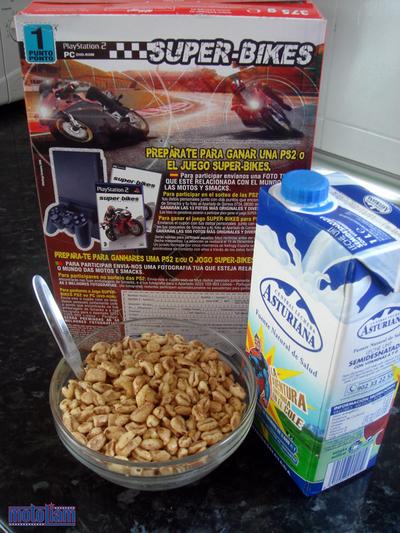
I am now officially on the look out for some quality protective gear.
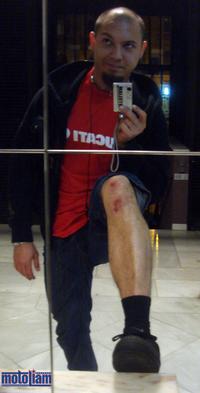
| If you feel like contributing to MotoLiam's Helmet Fund, please use Paypal. The email address for donations is MotoLiam@Gmail.com |
 |
November 16, 2006
Ducati Museum, Hallowed Halls
During one of my lunchbreaks at Ducati Corse, I spent a few minutes in the Ducati Museum. I would have loved to have spent hours.
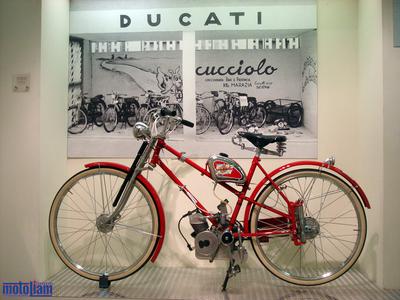
"They don't build generators, or keyboards, or heavy equipment, or cars. They build motorcycles. Racing motorcycles." - Colin
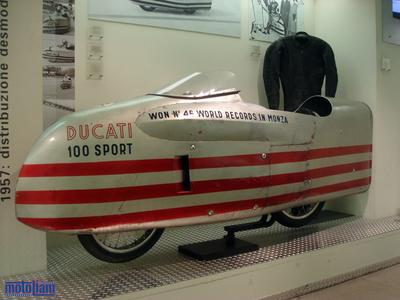
I couldn't agree more, Colin, though there were times when Ducati built far more than just Motorcycles. Like any pre-war motorcycle company, during the lean years, Ducati branched out and made an assortment of products. Yamaha is known as the Tuning Fork Company, for making pianos, guitars, and the like, but Ducati has retained it's image as a motorcycle company through and through.
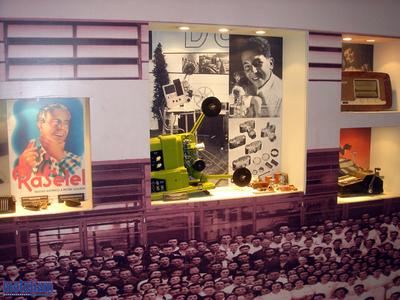
Fine details abound on the Museum bikes, and I saw quite a few period props, like original leather suits and helmets. Later, I saw more bikes destined for the Museum being stored in the main factory hangar. It's a good time to visit, if you haven't been here already. Who can tell me what the mysterious lever is for on the right part of the top triple tree (the one with the cable that goes . . . . nowhere)?
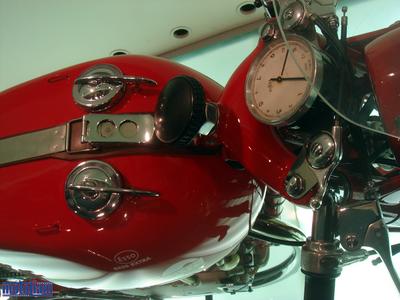
I love studying vintage racebikes, particularly because I see the trail of innovation through the years. I love learning how the engineers found solutions for problems at the time, before CAD, before mass-production, before high quality metals. Want to experiment with the rear suspension? Cut the shock mounts off and weld on some new ones to change the shock angle! This is probably the main reason why I love MotoGP so much. It's virtually a no-holds-barred contest to see who can put together the best package to go fast.
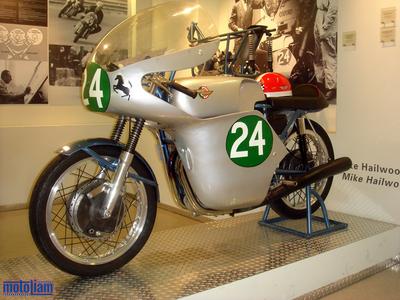
I say virtually, because there are still some rules in place, like fuel capacity limits (which is actually a huge factor), but compared to WSBK there's a lot more freedom of design. Which brings me to my next point -- that the bikes Ducati builds for the street are heavily influenced by what they want to race, and what they do race. A perfect example are the (street) Superbikes made by Ducati, which are very similar to what the factory races in WSBK. Yes, they aren't the easiest machines to work on, and yes, they are definitely not the most comfortable, but if you want to buy the closest thing to a race replica you can get, there's no better option than one of the 999R's. Or next year, the 1098 Tri-Colore!
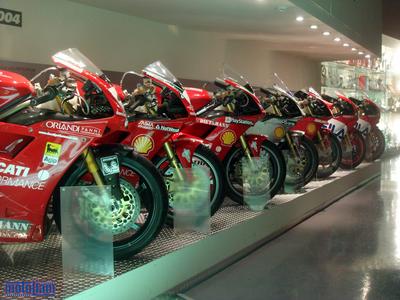
I have always felt that one of the true strong points of the Ducati was its chassis. Their traditional steel tube trellis frame has lent itself to some great racebikes, and it's continued usage in a category as demanding as MotoGP proves it's value. The current GP7 800cc frame has quite possibly the beefiest "neck" of any motorcycle I've ever come across. Many people don't realize how strong the forces are that a racing chassis is subjected to, partially because of the higher speeds, higher horsepower, and most of all, the higher traction levels of race tires. What I never realized before was how much time and effort goes into designing the race engines at Ducati. While I will always consider Harley-Davidson to be "The Motor Company", Ducati has some beautiful engines out on display that could make me re-think that. Bottom line, though, is that HD builds engines, and Ducati builds racebikes.
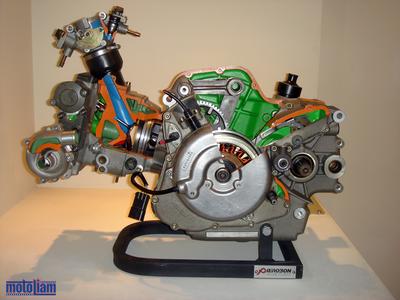
The SuperMono engine above belongs to a bike just like this. I have a special appreciation for horizontal singles ( click here or click here), and the SuperMono is the ultimate expression of a flat racing single. There's a nice history to this bike, also, in that there was a spec racing series for it here in Italy. I emailed this photo to a young boy I know, so his father could begin to explain to him how an engine works. Maybe I'll be competing against him some day, or maybe he'll design something even more fantastic. The future is a beautiful place.
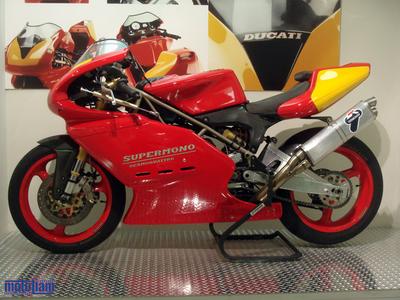
Here's a nice example of a hopped up pre-testrastretta twin.
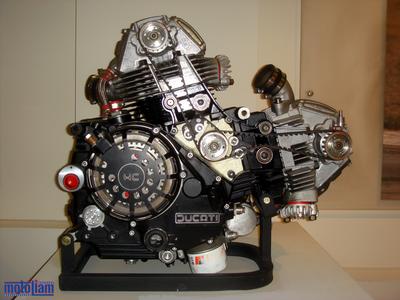
And here's a nice Ice Racer to stuff it into!
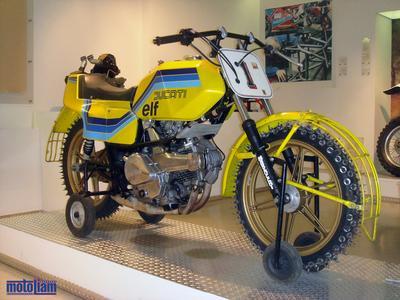
A rare triple cylinder Ducati engine, but what's notable here are the exhaust ports. Like a modern day high performance single (think Motocross, or KTM), the exhaust flow is routed straight from each valve to the pipes, and then merged together much later. This motore is 35 years old.
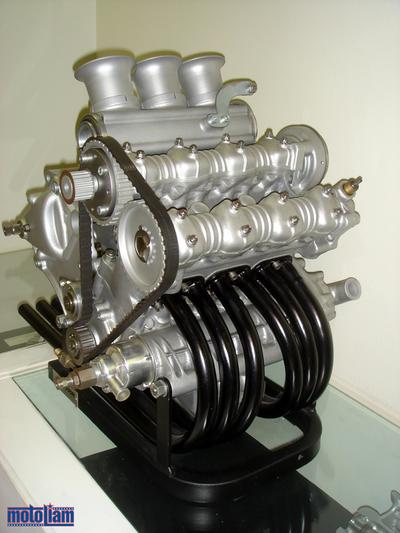
Here is the Ducati GP3, the Catalunya race-winning machine piloted by Loris Capirossi in 2003. The holes in the front fairing and long undertray differentiate the bodywork from later models, and also the swingarm and rear exhaust routing are quite different from the later editions. This blunt nosed masterpiece is one of my favorite motorcycles of all time. It is a shark, and it will bite.
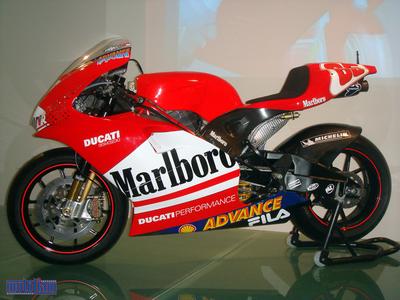
This isn't Ducati's first foray into building a high performance V4, either. Forty three years ago, Fabio Taglioni designed this beautiful 1260cc V4, the Apollo, in an attempt to take police bike business away from Harley-Davidson. The world might be a very different place today if we'd been forced to contend with a monster like that on the streets back then.
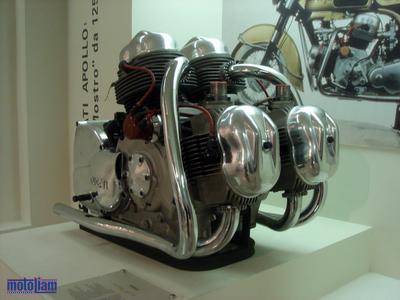
Speaking of HD, Ducati also built a Cruiser. Here it is.
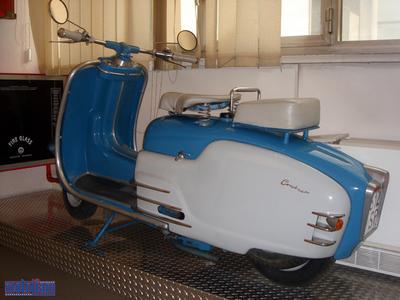
If you're going to visit the Ducati Museum, who better to speak with than Pierre Terblanche, designer of the 999, Multistrada, Sport Classic series, and the urban powerhouse, the Hyper-Motard! We spent some time discussing possible options for the Hyper-Motard, and while I'm not holding my breath for a "MotoLiam" edition, if things happen like I want them to, I'll definitely take responsibility for my ideas!
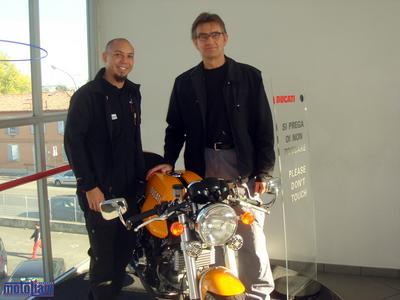
There's a small section where some of Ducati's victories are celebrated, and the center of the Museum features a helmet shaped room with the GP3 in it, along with some inspirational video playing on the back wall. If the new bikes coming out are any indication, the trophy case needs to get bigger - and soon!
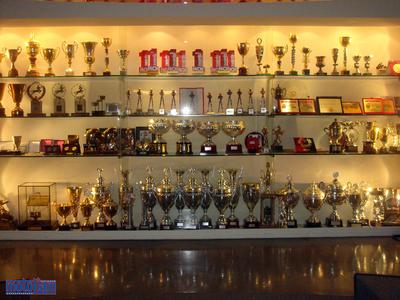
Next year's GP7 is already on the track, and looking good!
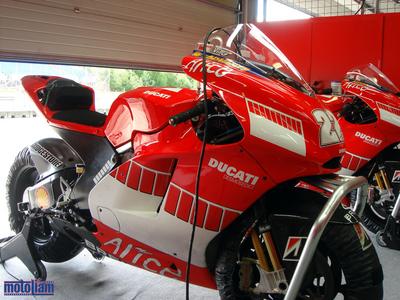
And I can't wait to see what Ducati Corse can do when they get around to racing the Ducati 1098 Tri-Colore!
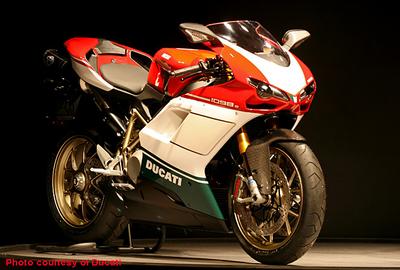
Here are some links to other visits to the Factory and the Ducati Museum:
MotoGPod.com listener Gordon Inch's 2005 Museum pictures
DanST4's visit to the Museum
Jim Gianatsis' Official Factory Tour
Jim Gianatsis' Ducati Corse Tour
More information about arranging a tour of the Museum, and the Ducati Factory, can be found by emailing:
infotour@Ducati.com or by calling 0039-051-6413343
Or, you could just get a job like mine.
November 12, 2006
"We are just a small factory." Ducati Review, Corse and the Factory.
I spent the last week in Bologna, Italy, visiting, working, and training with Ducati Corse on behalf of my team, Pramac D'antin Ducati. It was my first trip to the Factory, and it was a powerful and moving experience.
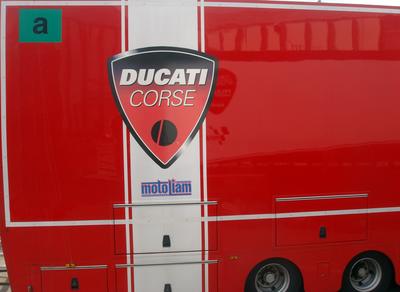
I walked to the factory from my hotel bright and early on Monday morning, tired from the previous day's travel, but excited to be visiting the birthplace of Ducati, and the home of Ducati Corse, the racing division of Ducati that is responsible for countless victories and championships in World Superbike and also several spectacular wins in MotoGP - most recently the 1-2 punch of Troy Bayliss and Loris Capirossi in Valencia at the final round of the 2006 MotoGP World Championship. As I mentioned earlier, Ducati Corse is a separate entity within the Ducati factory, much like HRC is within Honda. All similarities end there.
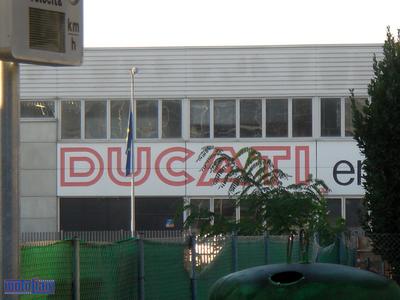
The view from the front of my hotel, Hotel Del Borgo.
"We are just a small factory."
This statement was told to me several times, by various people, over the course of the week I spent in the factory. It is absolutely true.
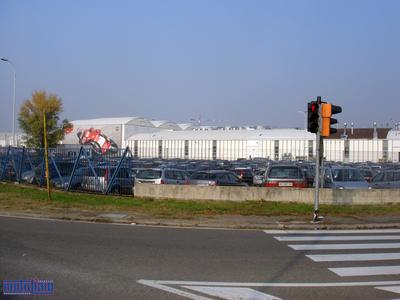
Size has nothing to do with it. It's about manpower. And brainpower.
I checked in with security at the main entrance gate, and was then escorted through part of the factory's production lines by Cristian Gabarini, the Ducati track engineer who worked with the Pramac D'antin MotoGP team for the past two seasons. Security is pretty tight at the front door, but once you're inside the factory grounds the workers know you're there for a reason and they pretty much leave you on your own. Gaining access to Ducati Corse, on the other hand, is another story. It is very well protected and hidden away deep in the bowels of the main plant. It was nice to get a little tour of the factory with Cristian, or C2 as he is known, and besides, I needed him to get into the Corse raceshop because I don't have one of the special "swipe-cards" you need to open any of the doors to the raceshop, the R&D facility, and some of the other rooms where the good stuff is kept! Unforunately, (depending on how you look at it) C2 will be switching to the Marlboro Ducati team next year, working closely with newly signed Casey Stoner. We have worked well together this past year, so I'm sorry to see him move on, but I'm glad to have helped him work on his English a little - something he's going to need working with the young Australian!
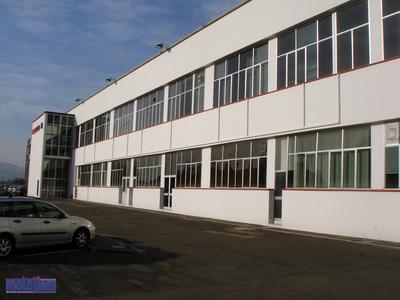
The front office building of the Ducati Factory, where the museum is located.
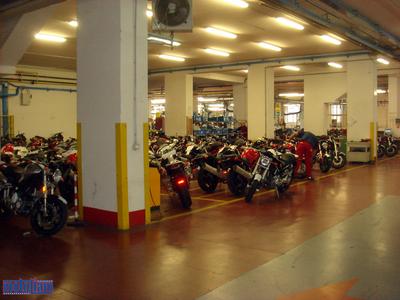
The very first steps I took in the factory building I was greeted by one type of motorcycle, and another.
By 9AM, the factory is in full swing, and you must walk through a maze of pathways in the main production warehouse in order to gain access to the Ducati Corse raceshop. The production lines are organized and efficient, and there is a buzz of activity on all sides. I passed men and women (yes, real women build these bikes!) busily affixing things, assembling engines, working the huge CNC machines (which run 24 hours a day), and more. There are large posters of previous Ducati racers and engine components on the walls of the factory, and also production goals and updates. You have to keep alert, as there are forklifts running around at high speed, factory messengers zipping by on bicycles, and visitors are not common this deep in the factory lines. I walked past the Sport Classics area, the Monster zone, the massive dyno room area, which ensures all engines are operating properly before the bikes leave the factory, and passed so many parts your eyes would spin. Row upon row of freshly powdercoated frames, huge racks of marchesini's, hundreds of bare cylinder heads waiting for valves, you name it. Ducati builds all their bikes here, and while some pieces are out-sourced, much of the detail work and final processes are done in-house. There are blanks everywhere, and the mills, lathes, and CNC machines are constantly grinding things out. The smell of cutting fluid and hot aluminum permeates the factory, and at times it can be overpowering.
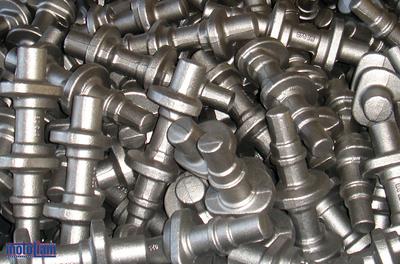
All told, there are roughly 850 people employed fulltime at the Borgo Panigale factory, of which a staff of approximately 100 work within Duati Corse, the racing division of Ducati. While they are separate companies, the general feeling is that everyone works together towards a common goal. Everyone works for Ducati. When people would say that "We are just a small factory", it's really true. The total budget for Ducati Corse's racing activities is miniscule compared to the amount that HRC spends. And Corse's is for both WSBK and MotoGP. There is an immense pride in Ducati's racing pursuits, and it is fundamental in the Factory's philosophy. They are here to race, and they make bikes that are direct descendants of their racebikes. Sure, there are the touring bikes, monsters, etc, but the underlying feeling is that Ducati builds racing bikes. There is also an immense pride that emanates from the Corse workers, because it's such a small group of people. Everyone that works there actively has a hand in the company's successes or failures, and they take it very personally. I don't know what it is that makes the Italians so crazy about racing, but these people work for passion and for pride. Definitely not money. We'll get into that later. I guess it boils down to manpower, brainpower, and moneypower. Because Ducati doesn't have the same manpower or moneypower, the workers strive that much harder to do their best. The only word I have for it is Devotion.
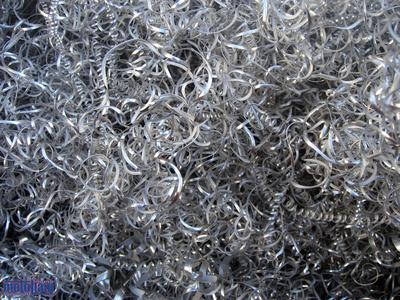
This is my favorite photo I took all week. There is so much testing going on, and parts are constantly evolving. I was absolutely amazed by the workers in Corse, because they are far more skilled and talented than you might think. Many of the mechanics are also skilled machinesmiths, and it was common to see them carrying parts back and forth, modifying them constantly. Grinding? Welding? Milling? Painting? These guys really do it all, and I take my hat off to them. While I was in the raceshop, I saw pieces of the new 1098 being modified for it's eventual foray into WSBK racing, and parts of the new GP7 and also it's engines were also subjected to interesting modifications. Personally, I love building engines and transmissions, because it's very exacting and precise. What they don't teach you through a manual or in a school, is that "the touch" becomes very important the more you do this kind of work. There are factory specifications that parts must adhere to, but setting up a good race engine is far more difficult that just reading a sheet of paper and measuring things. This is where "the touch" comes in. It's been around forever, but slowly and surely it is going away as more and more production motorcycles feature a new repair process - that is, if it is out of spec, throw it away and replace it with a new one. There's no "rebuilding" of anything these days, and that kind of bums me out. On the other hand, building any of the MotoGP engines, and particularly the Ducati, I think, requires a slightly different approach. I won't go into specifics, but I will say that although these machines have already been run on the track, they are still prototype machines and are under constant development and evolution. Case in point: every day I was in the factory, I was subjected to a constant howling coming through the factory walls. Waaaahhhhhhhh, Weeehhhhhhhh. There were 800's on the dyno undergoing stress tests and tuning regimens in order to find an even more optimum engine baseline setting. It was eery and thrilling at the same time, knowing that the new blood was already in the water, and it was on the move.
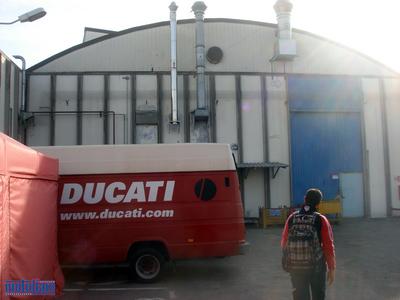
How long has this van been in service at the factory?
The factory workers in the main plant wear either a Ducati jumpsuit, or a combination of Ducati sweatshirt/pants. Some of the machinists wear an old-school red lab-coat, and you definitely get the impression that they've been doing this for years. Decades, even. It was also nice to see that every employee in uniform wore the badge of Shell Advance racing oil/fuel on his or her sleeve, further proof of the two companies commitment to one another's success. Meanwhile, the Ducati Corse people wear a different uniform, usually a Red Ducati Corse sweatshirt, also with Shell patch. The uniform requirements are a little more lax for the Corse employees, because many of them wear what they want, but that doesn't mean they work any less. In fact, the Corse personnel are regularly there for ten hours a day, and there are periods of the year where they will go 12 or more hours a day for weeks on end.
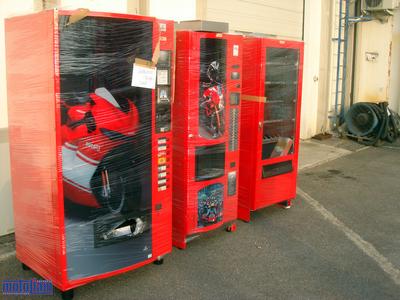
This is the new coffee machine that was installed while I was there. I was pretty fortunate because I managed to be at the factory at a really neat period of activity. First of all, the new 1098 had just become public, and I also saw the machine on several occasions, running around under power outside on the small test track on premises, getting refueled, and also in the secret workshop near the cafeteria (caffe-te-RI-a). Actually, there are a couple of the new 1098's. To be honest, the first time I heard it running, I thought it was a stock Buell going by. Doh! Anyway, about the coffee machine, as Luigi Mitulo told me, this is the most important machine in the factory. It's a gathering place and it helps keep everyone's momentum going. Coffee breaks are common, but they are usually very short, lasting five minutes or less.
There were a lot of cool things happening at the factory while I was there. On Tuesday, Troy Bayliss dropped by the Corse raceshop to have a victory celebration with everyone. I didn't expect Troy to be able to speak a little in Italian, and with his thick (THICK) Australian accent, it was hilarious. "Motto Contento!" All the Corse personnel showed up in the afternoon for the get together, and there were bottles of Champagne for everyone to enjoy. There were a few speeches, and after Troy spoke, there was a thunderous applause that went on forever. The people were really happy about Troy's win, and it showed. I stood for a moment and just took it all in. The Ducati Corse people live for racing, and a victory against the best that Yamaha and Honda can throw at them is truly something special. There was such gratitude in their eyes as they looked at Troy, I don't really know how to describe the scene, other than that it was very touching, and it showed me a side of Corse that I hadn't expected. These are real people, passionate people, who are very dedicated, very committed, and I felt honored to be there. This was my second celebration with the Ducati folks, the first one was a dinner on Sunday night following the Motegi race. Both times were unforgettable. This wasn't really my victory, so I didn't partake of any of the victory bubbly, and besides, I had a ton of work to do that afternoon. Later in the week, the crew from the Marlboro Ducati race team showed up. It was a joyous reunion for me with the Factory boys, and we caught up on a bunch of things because we had a little bit more free time to talk. Usually, at the racetrack, we can say hi, good morning, that kind of thing. Mark Elder gave me a tour of their race garage/area, and it was pretty trick. They have their own machine shop and storage area, and their semi trucks are parked inside while they are loaded and unloaded. They team showed up because it was time to build next season's GP7 800's. Everyone was hustling around working on something, like assembling the wiring harnesses, or preparing the new chassis'. Oh, there will be a couple neat changes to the color scheme of things next season, so that will be cool. I hung out for a few minutes getting a feel for everything and then rushed back to my work. My team will travel to the factory in early December to prepare our own racebikes. I'm not exactly sure which GP7 Barros will be running later this month at the Jerez test. It could be one of three machines. . . .
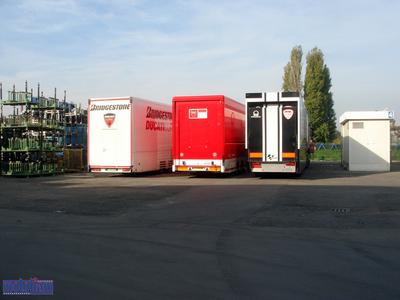
The White truck belongs to the 3T team (tire test team, with Shinichi Itoh), the Red truck is the Ducati test team, with Vitto Guareschi piloting, and the Black truck, well . . . . . good guys wear black, haha, for this year. Next year? Who knows what colour scheme we'll be running - but I hope that the trucks aren't black. Those things are a bitch to keep clean!
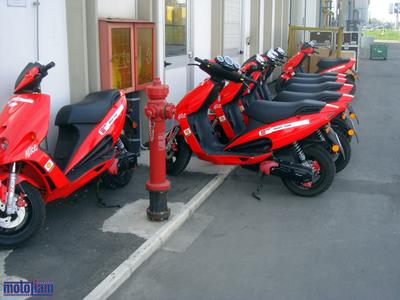
Incidently, these Malaguti scooters are for sale, if you know of anyone that wants one. Two years of running around in the paddock - so maybe they have 50 or a 100 miles. Practically brand new.
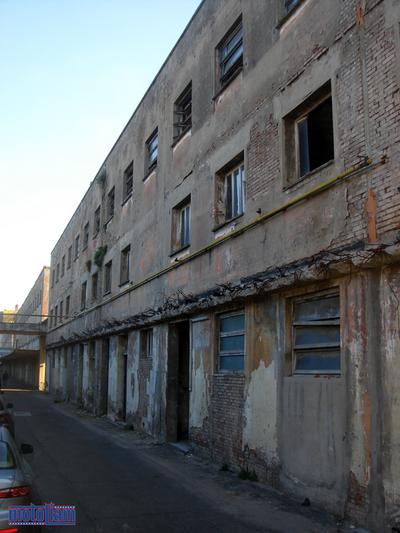
This is one of the original Ducati Factory buildings. It's run down and effectively abandoned. I was continuously struck by two worlds while I was at the factory, and it's because of this that I have such strong feelings about Ducati now. There is such a contrast and rigid dichotomy between old and new here. I'm not sure how to put it into perspective, but for the international Icon that Ducati is, all the innovation they represent, I fear they are fighting an uphill battle on all fronts. Much of the factory machinery, trucks, and equipment is old, and the factory's building are all showing their age. Although Ducati has always been at the forefront of bold, new, and stylish designs, their homebase is anything but. It seems like all the money coming in to the factory goes right into developing the next machine. There is not a lot of money here, and what little gets put in to Ducati Corse is used to the utmost. These people make do with whatever they can, and the workers really put themselves out to do their best under the circumstances. A typical factory worker makes what I would consider to be minimum wage back in the United States, maybe less. They look tired and rundown. There's a strange hollowness in their eyes, but this could be something I'm totally misreading, because the Italians have different eyes than normal. Much like the people of Holland, there is something unique in the way these people look at you. But to me, the factory workers looked a little disheveled. Shaggy hair and scruffy clothes or not, these people can work, and they do so with a pace that makes me feel like I'm not working hard enough. It's the same all over the world, I suppose. They are building machines that only the affluent can afford. It's a completely different world here in Europe, and for me, coming to the Ducati factory (THE FACTORY!) was nothing short of eye-opening. Everyone who's working in the motorcycle industry does so for a reason. I've always said that we work for passion, because obviously we're not here to get rich. The factory workers at Ducati take that to another level, and because of this, I understand the company that much more. Ducati is here because of it's employees. It's here because of what's running through their employees veins. Ducati is in their blood - racing is in their blood - they are the backbone of this place. It's also interesting to note that every single Ducati motorcycle has come from the Bologna factory (to my knowledge), and to me, that makes this someplace special.
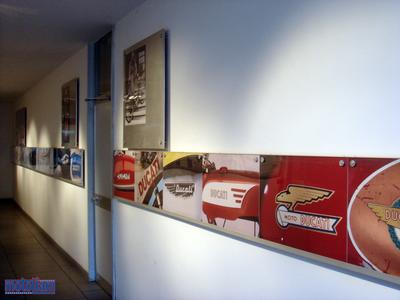
There's a huge history here, and I felt the full weight of it. I purposely did not take many photos on this trip, and what I did take was made with my small handheld.
The Ducati factory, constantly churning out the new models, comes to a halt around noon, when all the lines shut down so everyone can eat lunch. The entire factory eats in the cafeteria, which offers up typical dishes, in a first and second plate format. Everyone is able to eat from a variety of dishes, but the only beverage available is San Benedetto water, normal or with gas. It comes in a nice one liter bottle, and I polished mine off everyday. Most of the people I ate with took care with their food, eating healthily - lots of fruits and not so much on the pasta. There's a restored Cucciolo in the center of the room, and the workers come in waves, timing their meals so there's never a huge back-up in the food lines. At times, I felt like I was in living in the past, because this could have been fifty years ago. And it could be fifty years in the future, as well.
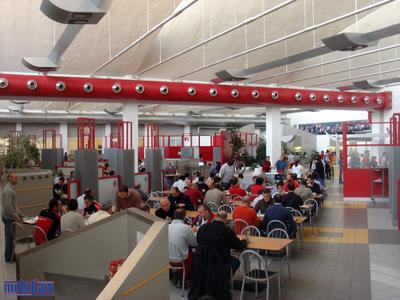
There's a nice coffee shop next to the lunchroom, and also a small play room filled with a couple foosball machines. I didn't really feel comfortable taking pictures of the workers during their "off-time", and I wanted to be as respectful as possible at all times. In fact, I took only a single photo in the Ducati Corse area, and I'll show that later. I really felt like an outsider walking through the factory halls, and this had nothing to do with my non-existent Italian language capability. I just felt that I didn't have the same value system, the same hardcore dedication, the same single-mindedness, the same devotion. I don't know. I just felt different and that if I was lucky, I could come away with a unique experience, one that would be something I could carry with me for a long time. And I did.
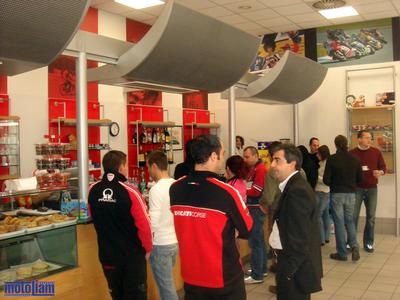
While I have never considered myself a true Ducatista, I have a newfound respect and admiration for this historic marque. I learned a little about the companies successes and failures, and I learned how about Ducati goes about racing. It is a very serious business, and this mentality and methodology would hit me time and again as I worked closely with and observed the different people from Ducati Corse. Everyone - from the engineers, the electronics whizzes, the mechanics, and the engine builders - everyone was focused and professional. One thing that struck me was that although many people were very tired looking at this point of the season, weary, they still continued working well throughout the day and into the evenings, tinkering with this or that, and generally trying to do their best to improve Ducati's chances of winning. Another thing that impressed me was that there seemed to be very little direction coming from the managers, or bosses. It appeared like everyone knew what they were supposed to do, all the time, and they just went about steadily doing their jobs without having to deal with someone looking over their shoulder the whole time. If someone had some free time, they'd pick something up and clean it, or try to find a way to make it better. Periodically throughout the day, engineers and designers would come downstairs from their offices and check something out in person, be it the fit or the functionality of a particular piece. People were constantly moving, checking things, testing things, and all day long there were track engineers studying data on their laptops. It is an all consuming focus on improving. On winning. Everyone and everything working in unison, like different parts of a body. I'm very proud to say that I will be working hand in hand with Ducati Corse next season, and I hope that I can continue to learn and grow with them.
More thoughts and experiences as they come to me.
Oh, and that Ducati Corse raceshop photo?
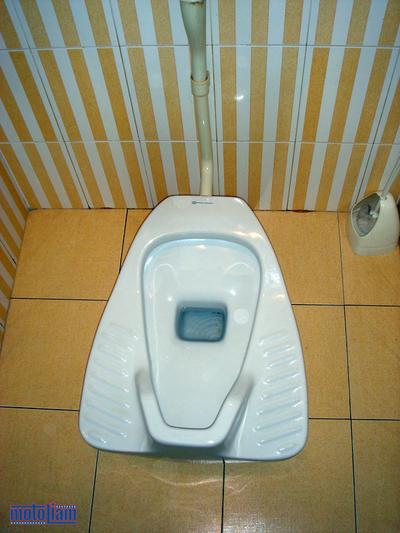
The fastest toilet in Bologna! And, yes, I test rode it!
November 07, 2006
Visiting with Ducati Corse - Bologna, Italy!
I'm staying in the Hotel del Borgo, on Borgo Panigale. Coincidentally, the Ducati Factory is right across the street, visible through the trees and buildings on the main street. Coincidence? I think not!
I am putting the final touches on the 2006 MotoGP season, wrapping everything up so to speak. I'm also learning about what my duties will be next year, and my "on the job training" is going well. In the few days I've been here, I have managed to visit the Ducati Museum and also checked out some of the production lines, though not very much. Ducati is filled with a fierce racing spirit. so it's only natural that the high-security offices and raceshop of Ducati Corse are located centrally within the Factory's plant, deep in the heart of one of the larger warehouses, amidst the CNC machines and other large equipment used to create the Ducati streetbikes. Both the Superbike and GP efforts are based here, and it's a tightknit family that works well together. I should point out that Ducati Corse and Ducati are two separate entities, but just about everyone here shares the same mentality and commitment to success, and it seems like they all love racing! I have taken a lot of impressions already, but I don't have time to get into it at the moment. More later, because I need to get to sleep!
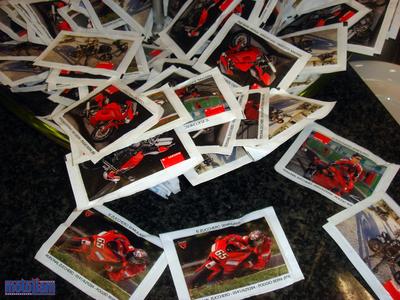
Even the sugar packets in the cafeteria go fast - better get yours while you can!
November 04, 2006
MotoLiam Updates
Earlier this year, I bounced around quite a bit looking for something permanent that would keep me active in the racing scene here in Europe, and around the world. I worked with Kenny Noyes, who was racing in the Spanish National Championships (the Buckler CEV, Formula Extreme category, and also some endurance racing at Albacete), wrenched on Yamaha R6's in the Losail National Championships (five races in Doha, Qatar), partook of the WSBK tests at Valencia working primarily with Australian Josh Brookes (WSS) and the Ducati NCR Superbike team (who were fielding Roberto Rolfo this season), and also managed to do some work as a journalist and photographer for Road Racer X Magazine, Svensk Roadracing, and several others, including various websites (like mine!).
I've taken planes, trains, buses, and even "hitchhiked" in order to get to the races, and the same drive that pushes me to be involved with racing has allowed me to meet and befriend many people within the WSBK and MotoGP paddock. Eventually, I was hired by Luis D'antin to join Pramac D'antin MotoGP, his World Championship team, and I wrenched and learned all I could while working on Alex Hofmann's Desmosedici "Sat".
The 2007 season is already underway, and after the week of Valencia tests following the last race of the year, I've come back to Barcelona to rest up and prepare for the next phase in my evolution. I won't get into specifics at this time, but my training begins on Monday, in Bologna, Italy. That's right - I'm headed to the source - the Ducati Factory and home of Ducati Corse! I haven't officially signed my contract for next season, and while there are options on the table, I've decided that it would be best to continue working with my team, and in particular, my chief mechanic and technical director, Emanuele Martinelli. We've worked so hard this year (2006), trying to find the motivation and passion that was hard to come by with this season's package, and next year promises to be even better! WIth a new Ducati GP7 800cc machine, two fantastic riders, Alex Barros, and Alex Hofmann, and Bridgestone tires, we're definitely looking good! But, the package works only if everyone involved is as committed and dedicated as the next person, and for this reason, I want to do everything in my power to see that we're as successful as possible! People often forget that a team is more than the bikes and the rider. It's a unique combination of personailities and skillsets, and in this arena, where we live and travel together some 200+ days a year, it's critical to establish the best combination of everything. That's about all it boils down to. We are making a better family, a stronger family, and in the context of machines, we're switching gears so that we can go all out in 2007!
Click here to be taken to a rare interview I made with Anthony Gobert earlier this year. This article was nixed at the last moment, when Anthony was let go from his Coronas Suzuki team for "personal reasons".

